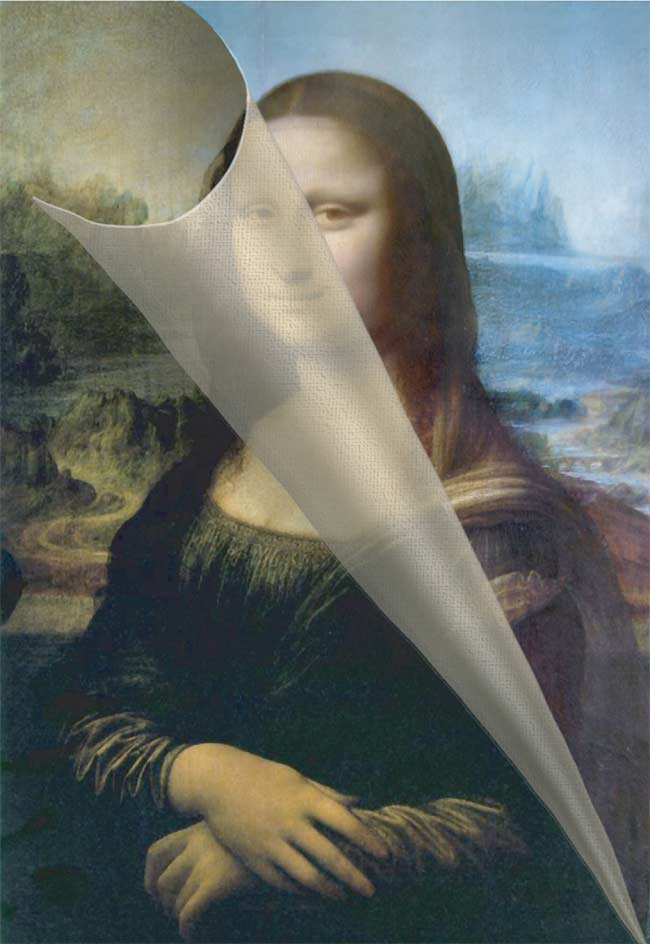25 Secrets of Mona Lisa Revealed

New images uncover 25 secrets about the Mona Lisa, including proof that Leonardo da Vinci gave her eyebrows, solving a long-held mystery.
The images are part of an exhibition, "Mona Lisa Secrets Revealed," which features new research by French engineer Pascal Cotte and debuts in the United States at the Metreon Center in San Francisco, where it will remain through the end of this year. The Mona Lisa showcase is part of a larger exhibition called "Da Vinci: An Exhibition of Genius."
Cotte, founder of Lumiere Technology, scanned the painting with a 240-megapixel Multi-spectral Imaging Camera he invented, which uses 13 wavelengths from ultraviolet light to infrared. The resulting images peel away centuries of varnish and other alterations, shedding light on how the artist brought the painted figure to life and how she appeared to da Vinci and his contemporaries.
"The face of Mona Lisa appears slightly wider and the smile is different and the eyes are different," Cotte said. "The smile is more accentuated I would say." [Why Does Mona Lisa's Smile Change?]
Mona Lisa mysteries
A zoomed-in image of Mona Lisa's left eye revealed a single brush stroke in the eyebrow region, Cotte said.
"I am an engineer and scientist, so for me all has to be logical. It was not logical that Mona Lisa does not have any eyebrows or eyelashes," Cotte told LiveScience. "I discovered one hair of the eyebrow."
Sign up for the Live Science daily newsletter now
Get the world’s most fascinating discoveries delivered straight to your inbox.
Another conundrum had been the position of the subject's right arm, which lies across her stomach. This was the first time, Cotte said, that a painter had rendered a subject's arm and wrist in such a position. While other artists had never understood da Vinci's reasoning, they copied it nonetheless. [Photos: Anatomy Meets Art in Da Vinci's Drawings]
Cotte discovered the pigment just behind the right wrist matched up perfectly with that of the painted cover that drapes across Mona Lisa's knee. So it did make sense: The forearm and wrist held up one side of a blanket.
"The wrist of the right hand is up high on the stomach. But if you look deeply in the infrared you understand that she holds a cover with her wrist," Cotte said.
Behind a painting
The infrared images also revealed da Vinci's preparatory drawings that lie behind layers of varnish and paint, showing that the Renaissance man was also human.
"If you look at the left hand you see the first position of the finger, and he changed his mind for another position," Cotte said. "Even Leonardo da Vinci had hesitation."
Other revelations include:
- Lace on Mona Lisa's dress
- The transparency of the veil shows da Vinci first painted a landscape and then used transparency techniques to paint the veil atop it.
- A change in the position of the left index and middle finger.
- The elbow was repaired from damage due to a rock thrown at the painting in 1956.
- The blanket covering Mona Lisa's knees also covers her stomach.
- The left finger was not completely finished.
- A blotch mark on the corner of the eye and chin are varnish accidents, countering claims that Mona Lisa was sick.
- And the Mona Lisa was painted on uncut poplar board, contrary to speculations.
In the larger picture, Cotte said when he stands back and looks up at the enlarged infrared image of Mona Lisa, her beauty and mystique are apparent.
"If you are in front of this huge enlargement of Mona Lisa, you understand instantly why Mona Lisa is so famous," Cotte said. He added, it's something you have to see with your own eyes.
Follow us @livescience, Facebook & Google+.
Jeanna Bryner is managing editor of Scientific American. Previously she was editor in chief of Live Science and, prior to that, an editor at Scholastic's Science World magazine. Bryner has an English degree from Salisbury University, a master's degree in biogeochemistry and environmental sciences from the University of Maryland and a graduate science journalism degree from New York University. She has worked as a biologist in Florida, where she monitored wetlands and did field surveys for endangered species, including the gorgeous Florida Scrub Jay. She also received an ocean sciences journalism fellowship from the Woods Hole Oceanographic Institution. She is a firm believer that science is for everyone and that just about everything can be viewed through the lens of science.









